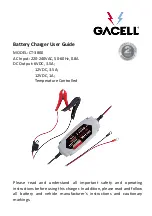
WARNING!
(Continued)
include acceleration, cornering, hydroplaning, or
peak traction characteristics.
Temperature Grades
The temperature grades are A (the highest), B, and C,
representing the tire’s resistance to the generation of
heat and its ability to dissipate heat, when tested under
controlled conditions on a specified indoor laboratory
test wheel. Sustained high temperature can cause the
material of the tire to degenerate and reduce tire life,
and excessive temperature can lead to sudden tire
failure. The grade C corresponds to a level of perfor-
mance, which all passenger vehicle tires must meet
under the Federal Motor Vehicle Safety Standard No.
109. Grades B and A represent higher levels of perfor-
mance on the laboratory test wheel, than the minimum
required by law.
WARNING!
The temperature grade for this tire is established for
a tire that is properly inflated and not overloaded.
(Continued)
WARNING!
(Continued)
Excessive speed, under-inflation, or excessive load-
ing, either separately or in combination, can cause
heat buildup and possible tire failure.
TIRE PRESSURE MONITOR SYSTEM (TPMS)
The Tire Pressure Monitor System (TPMS) will warn the
driver of a low tire pressure based on the vehicle recom-
mended cold placard pressure.
The tire pressure will vary with temperature by about 1 psi
(7 kPa) for every 12°F (6.5°C). This means that when the
outside temperature decreases, the tire pressure will de-
crease. Tire pressure should always be set based on cold
inflation tire pressure. This is defined as the tire pressure
after the vehicle has not been driven for at least three
hours, or driven less than 1 mile (1.6 km) after a three hour
period. The cold tire inflation pressure must not exceed the
maximum inflation pressure molded into the tire sidewall.
Refer to “Tires – General Information” in “Starting And
Operating” for information on how to properly inflate the
vehicle’s tires. The tire pressure will also increase as the
vehicle is driven - this is normal and there should be no
adjustment for this increased pressure.
5
STARTING AND OPERATING
395
Summary of Contents for Chassis Cab 2017
Page 4: ......
Page 10: ......
Page 288: ...8 4 8 4 NAV With Manual Temperature Controls 286 UNDERSTANDING YOUR INSTRUMENT PANEL ...
Page 289: ...8 4 8 4 NAV With Automatic Temperature Controls 4 UNDERSTANDING YOUR INSTRUMENT PANEL 287 ...
Page 298: ...Operating Tips Chart 296 UNDERSTANDING YOUR INSTRUMENT PANEL ...
Page 305: ...Uconnect 5 0 Radio Uconnect 8 4 8 4 NAV Radio 4 UNDERSTANDING YOUR INSTRUMENT PANEL 303 ...
Page 307: ...Uconnect 5 0 Media Uconnect 8 4 8 4 NAV Media 4 UNDERSTANDING YOUR INSTRUMENT PANEL 305 ...
Page 452: ......
Page 513: ...MAINTENANCE SCHEDULES CONTENTS 䡵 MAINTENANCE SCHEDULE 512 Maintenance Chart 513 8 ...
Page 525: ...INDEX 10 ...
















































